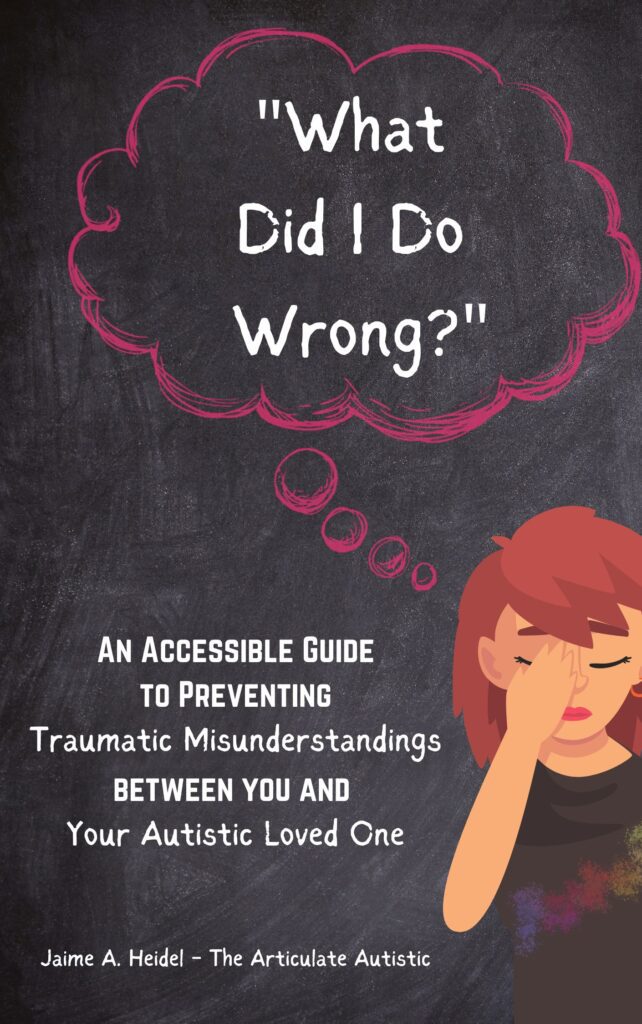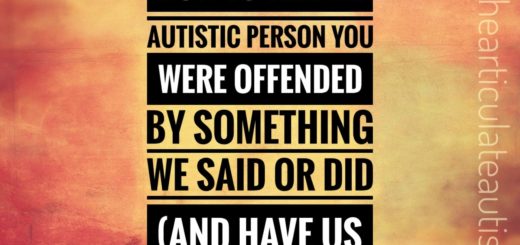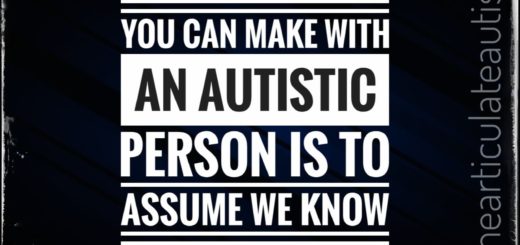8 Neurotypical Social Norms That Baffle Your Autistic Loved One
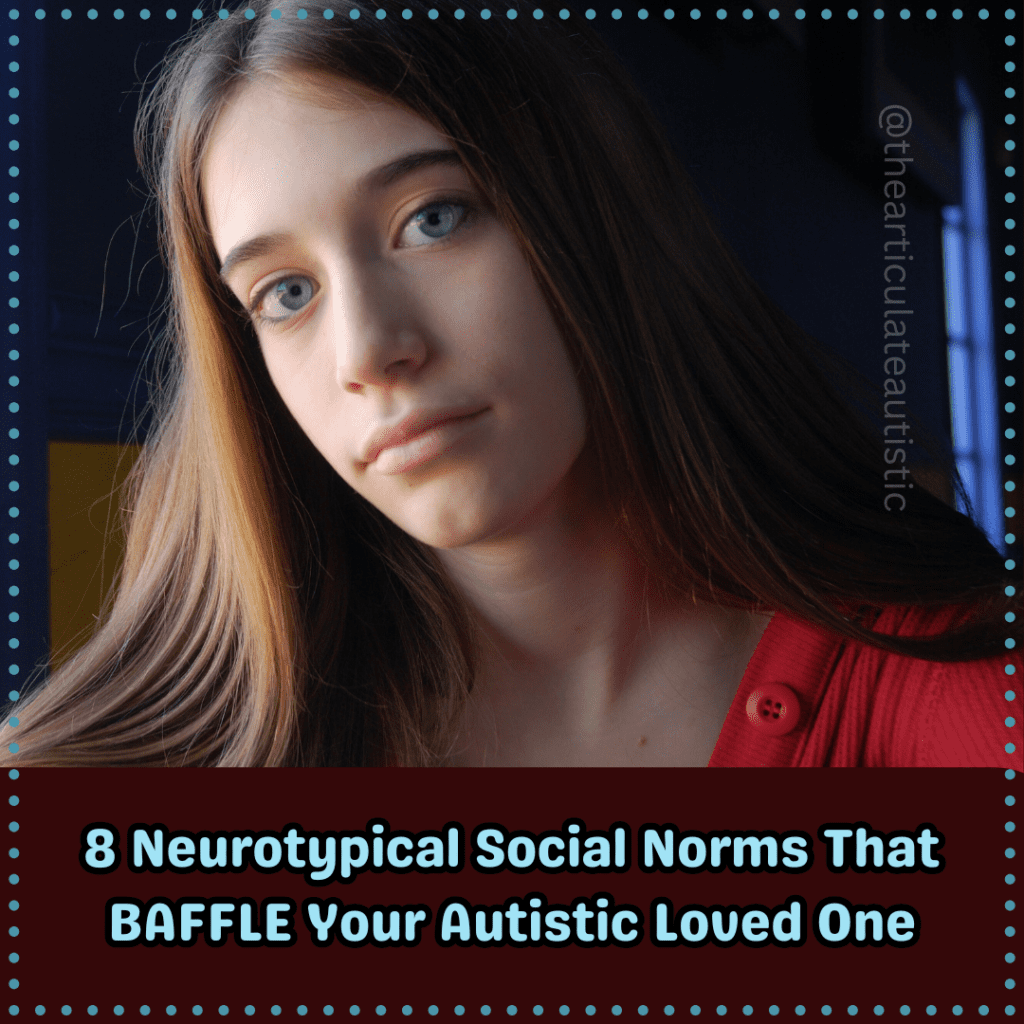
If you have an autistic person in your life, you may be confused about some of their traits.
Whether it’s something they said, a tone of voice they used, or a non-verbal cue they seemed to ignore, it can be frustrating to try to communicate with someone who appears to be behaving like a jerk, and that’s understandable!
The other side of this, however, is that many of the traits that you display as a neurotypical person may be just as baffling to your autistic loved one–and the differences between the two may be what’s causing friction, not purposeful malice.
Hopefully, this article will give you some insight into your autistic loved one’s perspective and help clear up some of those frustrating miscommunications.
Here are 10 neurotypical social norms the autistic person in your life may not even be aware of:
- Asking questions for any reason other than to obtain information.
When an autistic person asks a question, it’s to obtain more information and to gain a deeper understanding of meaning or expectations.
Many of us autistic folks are bottom-up processors and learners. Unlike our neurotypical counterparts, we need lots of details to form an accurate picture of what’s going on.
The reason asking questions is seen in such a negative light is that questions have multiple meanings for allistic (non-autistic) people. In addition to being used to obtain information, the allistic community may use questions to challenge authority or feign ignorance to get out of doing something or to avoid accountability.
- Lying is considered favorable and even expected in certain social situations.
The autistic brain thinks and processes information in more literal terms than the allistic brain. Our brains also have a black-and-white, all-or-nothing approach to learning. Therefore, when we learn, as children, that ‘lying is bad’, it often becomes a rule that is set in stone with no exceptions.
As we grow into our teen and young adult years, the expectation to tell ‘white lies’ to spare someone’s feelings or keep a secret can be incredibly confusing, especially since those changing expectations are often unspoken.
In other words, nobody sits the autistic person down to explain that the social expectations have changed. We are, instead, expected to ‘just know’.
Jaime A. Heidel – The Articulate Autistic
If we don’t, and we say something unintentionally offensive, we are met with sudden anger, accusations, and aggression that seems to ‘come out of nowhere’, and that leads to confusion, fear, and social withdrawal.
Over time, these harmful social interactions can cause the autistic person to develop post-traumatic stress disorder (PTSD).
- Agreeing to “get together in the future” is often a polite way of saying goodbye, not an attempt to create an actual social plan.
This is another neurotypical social norm that can be baffling for autistic folks. It took me until I was at least in my mid-thirties to realize that when people said, “We should get together sometime” they didn’t mean it literally but rather as a polite way of saying goodbye and telling me that they enjoyed seeing me.
Before I knew better, I took the offers literally and tried to set up a time to meet. Then, once I noticed a similar avoidance behavior pattern in several people, I concluded that all of them were lying and baiting me out of malice.
(There’s that black-and-white, all-or-nothing thinking.)
I had no idea that this behavior was considered a positive and friendly thing to do because to my autistic brain, it was anything but.
Now, I just smile and nod, but it doesn’t mean the behavior doesn’t still baffle me!
- Expecting others to prompt you to talk about your day, feelings, and experiences, instead of offering the information.
When two autistic people have a conversation, we often engage in rapid-fire information exchange that includes excited info-dumping, talking over each other, and meandering through topics that seem to have no relation to one another (but eventually connect in the end). Words and the literal meaning of those words are prioritized, not body language and other non-verbal cues. It’s beautiful!
Well, for us.
When two neurotypical people have a conversation, there’s a lot of turn-taking, listening, prompting, and sharing, in a pretty cohesive and connected line. Moreover, strict attention is paid to non-verbal cues, and those cues are acted upon or dismissed based on the people involved in the conversation, their relationship, their social status, venue, etc.
When an autistic and a neurotypical person have a conversation, if one or both of them are unaware of the differences in communication style, the exchange can break down quickly, resulting in confusion, frustration, and hurt feelings on both sides.
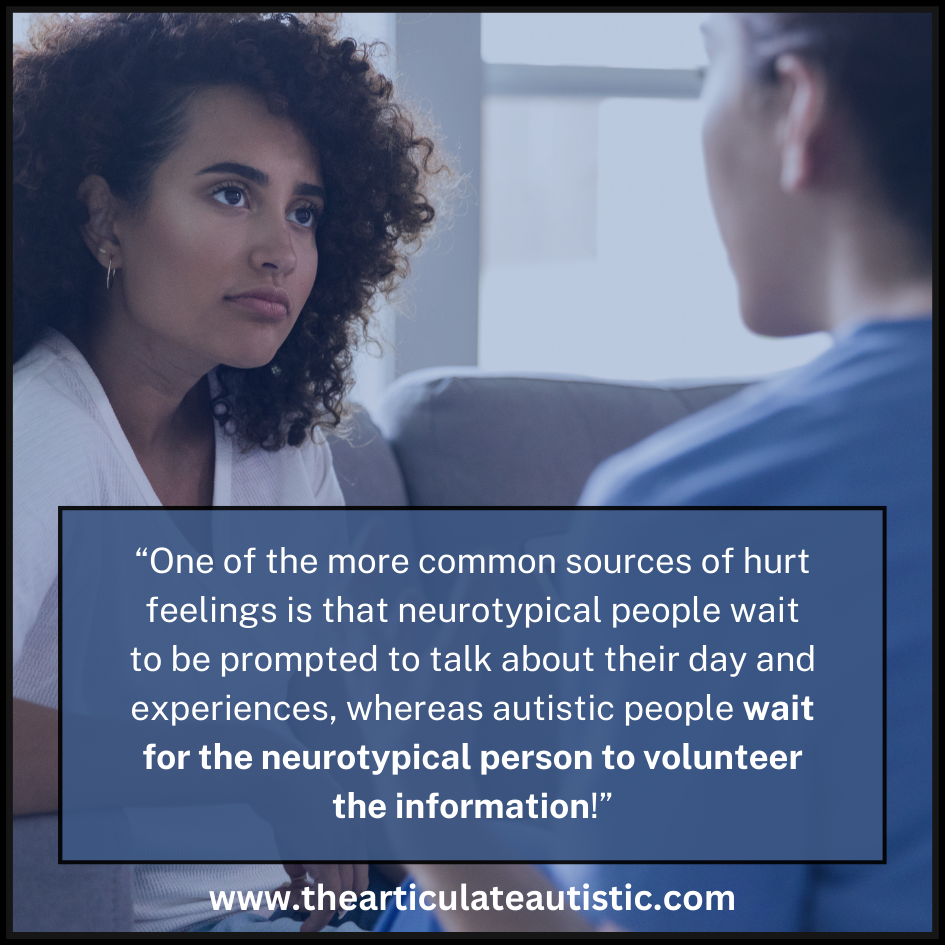
One of the more common sources of hurt feelings is that neurotypical people wait to be prompted to talk about their day and experiences, whereas autistic people wait for the neurotypical person to volunteer the information!
The neurotypical person thinks the autistic person doesn’t care enough to ask and only wants to talk about themselves while the autistic person is still sharing but waiting to be joined in the information-sharing session unprompted.
- Discussing a certain topic is less about the topic itself and more about reinforcing social bonds.
It wasn’t until I read the book, A Field Guide to Earthlings by Ian Ford that I learned there was a cultural purpose to small talk for neurotypical people. Now I know that talking about the weather, a TV show, a new pair of shoes, etc., isn’t so much about the topics being discussed but that the act itself is designed to establish and reinforce social bonds.
However, before I learned this information, if the small talk consisted of a topic I was passionately interested in, I would go on and on about it, excited about talking with someone I thought was a kindred spirit, not understanding that I was unintentionally monopolizing their time.
They thought I was being self-absorbed when I was just clueless about the neurotypical social norms surrounding conversation.
Looking back, it does explain the ‘ghosting’ (randomly cutting off contact with no explanation) I’ve experienced throughout my life.
- Sharing similar experiences during a personal conversation is considered self-absorbed instead of an attempt at deep connection.
Autistic and non-autistic people bond socially in very different ways that can cause confusion and hurt for those who aren’t aware of these differences.
For non-autistic people, listening to someone while they share a difficult and personal story and responding with nods, gentle verbal prompts, and sympathetic looks is ideal. That’s how they hold space for each other to navigate painful experiences.
For autistic people, however, this approach can feel hollow and insincere.
When someone tells us they are going through a difficult time, our first instinct is to show understanding and empathy by sharing a similar story about ourselves. This is how we connect and hold space for one another; letting the other person know they are not alone.
Unfortunately, the autistic approach to showing empathy can make the non-autistic person feel as though they are being talked over or ‘one-upped’ and turning the conversation and attention back around to themselves.
Not being aware of this until I was, again, in my mid-thirties when I started doing deep dives into neurodivergence, I’m sure this lack of knowledge was yet another reason why I would lose friends and acquaintances easily and seemingly ‘out of nowhere’.
- Hinting at needs, wants, feelings, etc. is considered more polite than asking directly.
“It’s cold in here!” “Oof! Something in the fridge stinks!” “Those potato chips look good!”
To the autistic brain, the sentences above are interpreted as statements of fact. This may mean that the autistic person will reply with, “Yes, it is cold in here” or “Yes, the fridge does smell bad” or “These potato chips are good!”
While these responses may seem intentionally rude, the autistic person is responding according to the literal way their brain interprets the information–as statements of fact.
To the neurotypical brain, these statements are interpreted as requests and acted on accordingly.
“It’s cold in here!” means the person would like you to do something about the cold such as close a window, turn on the heat, or offer them a blanket.
“Oof!” Something in the fridge stinks!” means the person would like you to remove the offending item from the fridge and put it in the garbage, followed by taking out the garbage so the rest of the kitchen doesn’t smell bad later on.
“Those potato chips look good!” means the person would like you to offer them some potato chips. (This one is a bit tricky because allistic social norms also dictate that they decline at least once or twice before accepting.)
When a neurotypical person hints about their needs, wants, and feelings, it creates a denial of accessibility for the autistic person. Not only does it set us up for social failure, but it also can lead to trauma when the neurotypical person, feeling as though their needs are being purposefully ignored, has a sudden and unexpected emotional reaction to us.
Jaime A. Heidel – The Articulate Autistic
Remember, for the autistic person, “It’s cold in here” translates to, “It’s cold in here”, and for the neurotypical person, “It’s cold in here” translates to, “Please do something about the cold”.
If the autistic person responds with, “Yes, it is cold in here!” that is not their rude way of saying, “Too bad!” That’s their brain taking a statement phrased as a statement as a statement, not a request.
(If you need the autistic person in your life to do something, state it as a direct request.)
- Teasing is often used to display affection and establish social bonds.
I still remember being around 20 years old and going to a friend’s house where his father would regularly tease me whenever I walked in the door. I would scuttle quickly away to the back room with my head down wondering what it was about me that he didn’t like.
Thankfully, my friend eventually caught on to my confusion and hurt and took the time to explain the difference between playful and harmful teasing.
Of course, there are caveats to this, many, in fact, but I’ll leave it at that for now.
The Takeaway
The social norms that are as easy and natural to you as breathing as a neurotypical person may not be at all for the autistic person in your life. The best thing you can do when these conflicts arise is to take a step back and ask yourself if you’re about to have an emotional response to your perception of their intentions or their actual intentions.
Taking time to understand the way your autistic loved one’s brain works can help mitigate conflict, increase trust on both sides, and make communication much easier.
If you want to learn more about the most frequent misunderstandings autistic and neurotypical people have (and how to reduce them), pick up a copy of my book, “What Did I Do Wrong?”: An Accessible Guide to Preventing Traumatic Misunderstandings Between You and Your Autistic Loved One.
